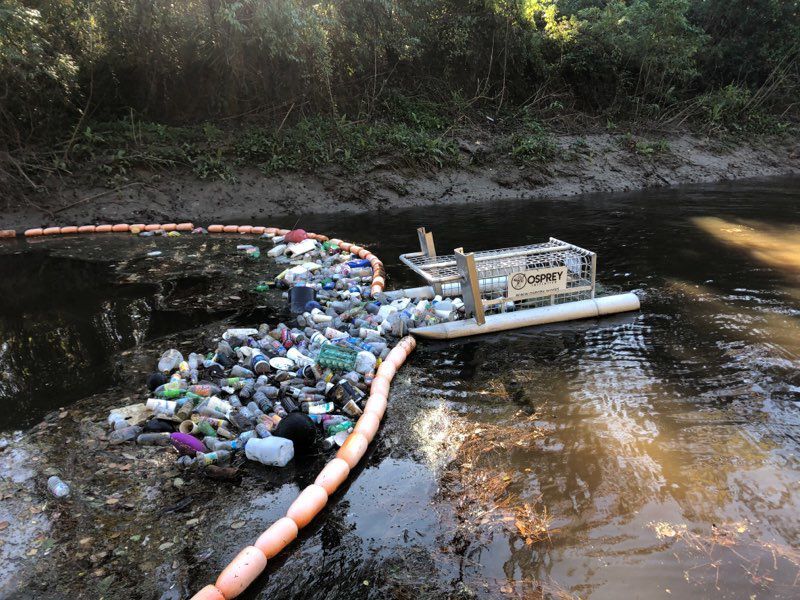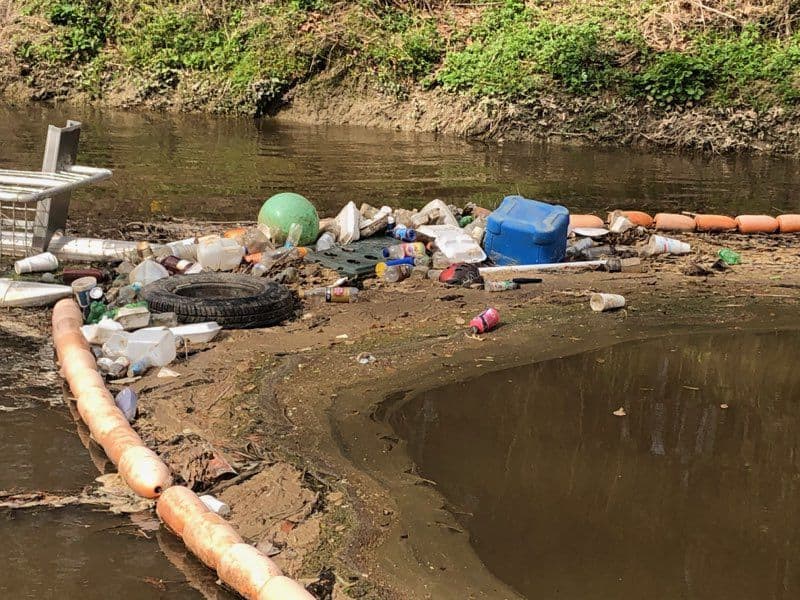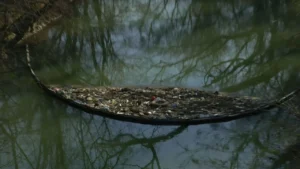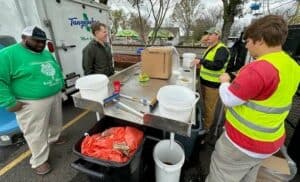Tangipahoa Parish Government has signed a contract to continue funding a Litter Gitter in Ponchatoula Creek for another six months using grant funds.
Over the past year, one Litter Gitter has collected 208 pounds of debris and 743 pounds of litter from Ponchatoula Creek, allowing 213 pounds of litter to be recycled and another 530 pounds to be disposed of out of the waterway.
Two other Litter Gitters have been installed in Tangipahoa Parish Waterways – one in Yellowwater River and one in Selsers Creek – and tactical cleanups have been implemented, bringing the total amount of litter removed from Tangipahoa Parish’s waterways over the past year up to 2,153 pounds.
A lot of that trash is light like plastic water or soda bottles, so that is a lot of bottles, said Tangipahoa Parish Councilwoman Kim Coates. Debris removed included basketballs, ice chests and other things like that.
Coates has lived here her entire life. She said she noticed right away the difference the Litter Gitter has made on Ponchatoula Creek, just by watching during heavy rains the amount of litter coming down below the bridge at Wadesboro Road, which is the area below the trap.
“The amount coming down the river is significantly less than what is used to be,” she said. “There are still ditches and canals below the trap, so there still is some litter, but significantly it’s gotten a lot better.”
She recently heard from a resident, who has been fishing at the Wadesboro Boat launch since the ‘70s, that he has seen a significant difference since the trap has been in there.
Coates was excited to know that it is working from “someone who has gone out there and fished and enjoys that less litter is in the water than was before.” Even a constituent, who lives along the river and whose yards collects litter from high water events, has said he gets a lot less trash in high water events than previously, she said.
Tangipahoa Parish Government is working on another grant to continue funding Ponchatoula Creek and Yellowwater River. DSLD is sponsoring one of the parish’s Litter Gitters, which was installed at Selsers Creek in September, for one year.
The Litter Gitter is an Osprey Initiative patented in-stream litter collective device invented by Tangipahoa Parish native Don Bates.
Bates’ team is scouting sites for an upcoming deep cleaning of Ponchatoula Creek’s watershed around the weekend of May 15. They are looking at possibly cleaning all the way up to Natalbany River, he said.
Because of special relationships with recyclers who take dirtier recycling like river plastic and river aluminum, Osprey Initiative has been able to recycle 40-plus percent of what is collected, Bates said.
Litter Gitters are rain-driven, so Osprey Initiative has two employees in Tangipahoa Parish. Nathan Farris, of Ponchatoula, helps manage the Litter Gitter on Ponchatoula Creek. When it rains, he sees if the rain makes the litter move, and if it does, he will jump on collecting it.
Coates said parish government does not have plans for any more Litter Gitters right now, but is looking to do more tactical cleanups and locate the “legacy litter” that is just sitting there.
“When you look for a spot to put one of the traps, it depends on navigation, flow, depth of water… We want to go further upstream and clean up on the north end of the rivers and come down, so it’s more clean,” she said.
This will help to better gauge where the new litter is coming down from, she added.
“This is just part of it,” Coates said. “We as the parish also have a responsibility to try to get our waterways clean.”
The parish has a MS4 permit, which requires reports to DEQ on what is being done and efforts to better keep stormwater clean, she said.
“We’re beginning to use Litter Gitters now in our plan to show DEQ that we are actively trying to keep our the litter out of our waters,” she said.
Tangipahoa Parish is still in the early stages of getting its entire watershed cleaned.
“We go from initial traps to start litter plan for entire watershed,” Bates said.
The goal would be for to know where the new litter is coming from and get institutional control upstream, preventing it from becoming litter in the first place, he explained.
“It takes a while to become that point, but that’s in the beginning stage now to know where that’s coming from,” he said. “This data side of things starts dialing in, knowing where the place you use to find sources of the litter is.”
The Osprey Initiative team previously held a big cleanup in October. Cleanups are part of their program, he said.
In response to a lot of complaints over the past few months about litter, Coates said education is being emphasized.
“During COVID, the inmate crews for state and local weren’t able to go out and pick up like they normally had done, so that really put a lot of litter still out there,” she said. “We are now getting back started and they are getting crews back going, but we can’t depend on someone else picking up our garbage. We really have to educate and see what’s going on to our community.”
She stressed the LitterGitter proves once litter hits the ditch, heavy rainfalls push it all down to rivers and the lake.
“A lot of people don’t see it, but it’s there,” she said.
Cleanups
Multiple litter pickup volunteer events have been scheduled for the upcoming Saturdays ahead, including:
April 10 at 9 a.m.-noon at Kentwood & Village of Tangipahoa, Community Center (Keep Tangipahoa Parish Beautiful)
April 17 at 8 a.m.-noon at Rufus Bankston Road (Keep Tangipahoa Parish Beautiful)
April 24 at 8-10:30 a.m. at MLK Park with Councilman Kip Andrews (Keep Hammond Beautiful)
May 22 at 8 a.m. in Manchac with Entergy (Keep Tangipahoa Parish Beautiful)
This story originally appeared on The Daily Star by Raley Pellittieri. Read the original story here.





